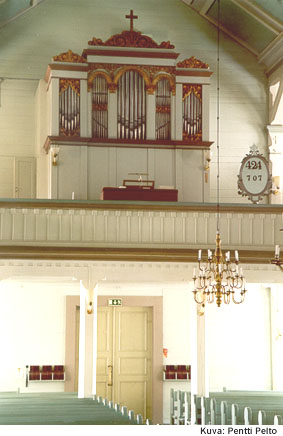|
HISTORICAL ORGANS IN FINLAND 
Kontiolahti Church- Normann, Gustav 1877
- 14 stops, 2 manuals and pedal
- mechanical action and mechanical stop action
Gustav Normann, an organ builder from Tallinn, built a two-manual organ in Leppävirta Church in 1877. When a larger organ was acquired for Leppävirta in 1945, Normann’s instrument was transferred to Kontiolahti Church, a wood nave church completed in 1881. Apparently mechanical changes were made to the organ at this point, although their effect on the sound seems to have been negligible. In 1964, the other 8’ stop in the Pedal was converted to a 4’ stop. Subsequently, some minor alterations seem to have been made.
In its details, the Kontiolahti organ is more like a Late Baroque instrument than a child of its time. Its only Romantic property is equal-tempered tuning. This organ is of great significance because of its particularly beautiful singing tone and because of its historical properties.
Appearance
The organ is located in a loft in the west end of the church. The depth between parapet and back wall is restricted for an organ, and for this reason the bellows are housed in the steeple chamber. The façade and the main body of the case form a structural entity to which the Manual I chest is connected. The back part of the organ, slightly wider, houses the Pedal and Manual II divisions one on top of the other. The case has no top.
The façade can be considered to contain five or three parts. The middle flat, which is the largest, dominates the whole. On either side of this there are two-tiered flats, and flanking these are smaller, single-tiered flats. The façade is topped with a strong carved decoration that links that three middle flats into a single element. The leaf carvings give façade a highly decorated appearance.
Technical features
The chests are sponselled slider chests arranged by thirds in the archaic manner. The pallet boxes are small. A curious feature in the Pedal chest is that the upper board of the third stop seems to have been added later, either by Normann or by someone else. It is this stop that was later transposed up by an octave.
There is no information on the original structure of the bellows. The original bellows were replaced with a single-fold reservoir and a feeder blower, housed in the steeple chamber one storey higher. A relatively large channel leads from the bellows to the organ. The modern concussion bellows fitted to the bottom of the Manual I chest are obviously essential. Since all divisions share the same wind pressure, the concussion bellows affect the entire organ.
The console is a separate structure in front of the organ, and the organist sits facing the church. The exterior of the console is intentionally simple and straightforward, but the keyboards have ivory and ebony coverings, and the inside of the console is of polished ash. The stop knobs are large, with a short movement, and they have stop ends of porcelain with printed names.
Musical properties
The organ is relatively easy to play, since the action is light even with couplings activated. The Principals have a chiming attack and a soft but penetrating sound which easily fills the church. Solos played on the flute stops sound particularly intensive due to the characteristic attack. There are no reed stops, which means that the overall sound is subdued, lacking the splendour that reeds yield.
Disposition
Manual I C-f3 | Manual II C-f3 | Pedal C-d1 |
Bordun 16’ | Gedackt 8’ | Subbass 16’ |
Principal 8’ | Viola di Gamba 8’ | Principal 8’ |
Hohlflöte 8’ | Fl.dolce 4’ | Octave 4’ |
Principal 4’ | | |
Hohlflöte 4’ | | |
Quinte 22/3’ | | |
Octava 2’ | | |
Mixtur 3 fach | | |
| | |
| | |
| | |
| | |
| | |
|
|
|
Manual coupling, pedal coupling | | |
Cut-out valve (Sperrventil) for each division | | |
Exhaust valve (Ablassventil) | | |
| | |
| | |
| | |
| | |
| | |
| | |
| | |
| | |
| | |
| | |
Further information
Pasi Karjalainen, Kontiolahden kirkon urut ja Gustav Normann, thesis for Master of Music degree, Sibelius Academy, Kuopio department.
Pasi Karjalainen, Kontiolahden kirkon urut, Organum 2/1996.
|